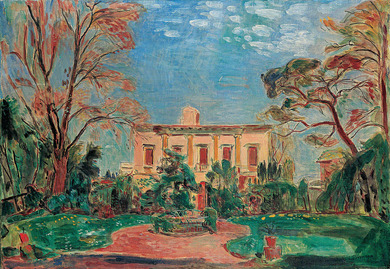Villa Romana
Damit komme ich aus Berlin und dem fruchtlosen Streit. […] dann sind wir wieder freie Menschen wie früher und können unbesorgt über Kunst und Leben reden, und die Sache von außen ansehen.
[So that gets me out of Berlin and the fruitless clash. […] then we're free people again as before and can talk about art and life without worry, and observe things from the outside. (ed. trans.)]
Hans Purrmann to Heinz Braune on his appointment as director of Villa Romana, 23 July 1935
Although Italy in the years leading up to the Second World War was ruled by a fascist dictator, the government's policy concerning the arts was less repressive than under German fascism. As a result, many Germans working in the arts emigrated to places such as Florence. For many of them, the Villa Romana under its director Hans Purrmann was an important contact point.
The painter took over the directorship in 1935. According to a foundation established in 1905, selected artists-in-residence were permitted to reside and work in the villa for a certain period. Purrmann received no salary for his position, but was nevertheless glad to have escaped the sphere of influence of the Nazis. This advantage took on even greater significance with the “Degenerate Art” exhibition in Germany in 1937. The Florentine director and the artist-in-residence at the time, Emy Roeder, were both vilified in the exhibition. In the years to follow, a call to the Villa Romana enabled artists to flee Germany. Other émigrés based in Florence also enjoyed the atmosphere at the villa. The Villa Romana and its director became the centre of an illustrious group of German artists in exile, including the painters Heinz Battke and Rudolf Levy and the sculptors Hermann Blumenthal and Toni Stadler. Purrmann's friends also included émigré writers such as Monika Mann and Rudolf Borchardt, who visited him at Villa Romana.
This refuge for artists was shut down when German troops occupied the city on the Arno in 1943. At Purrmann's request, Emy Roeder remained as the only person in the villa when Purrmann fled to Switzerland. Rudolf Levy was deported and murdered. Only in 1959 did the artist-in-residence programme recommence. It continues to this day.
Further reading:
Henze, Wolfgang / Voigt, Klaus (Hg.): Rifugio precario. Zuflucht auf Widerruf. Deutsche Künstler und Wissenschaftler in Italien. Mailand: Mazzotta 1995
Kuhn, Philipp: Zwischen zwei Neuanfängen. Die Villa Romana von 1929 bis 1959. In: Föhl, Thomas / Wendermann, Gerda (Hg.): Ein Arkadien der Moderne? 100 Jahre Künstlerhaus Villa Romana in Florenz. Berlin: G+H 2005, S. 104 – 119

